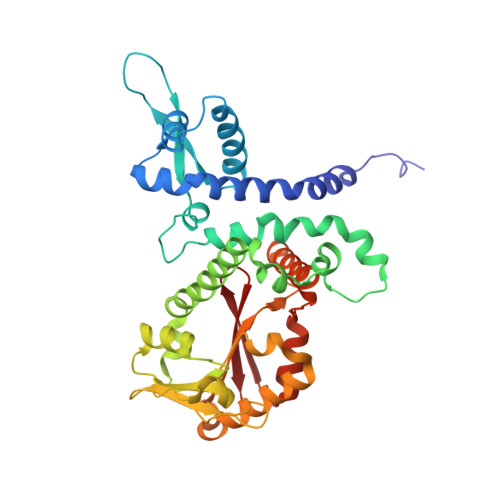Structural basis for dual functionality of isoflavonoid O-methyltransferases in the evolution of plant defense responses.
Liu, C.J., Deavours, B.E., Richard, S.B., Ferrer, J.L., Blount, J.W., Huhman, D., Dixon, R.A., Noel, J.P.(2006) Plant Cell 18: 3656-3669
- PubMed: 17172354
- DOI: https://doi.org/10.1105/tpc.106.041376
- Primary Citation of Related Structures:
1ZG3, 1ZGA, 1ZGJ, 1ZHF - PubMed Abstract:
In leguminous plants such as pea (Pisum sativum), alfalfa (Medicago sativa), barrel medic (Medicago truncatula), and chickpea (Cicer arietinum), 4'-O-methylation of isoflavonoid natural products occurs early in the biosynthesis of defense chemicals known as phytoalexins. However, among these four species, only pea catalyzes 3-O-methylation that converts the pterocarpanoid isoflavonoid 6a-hydroxymaackiain to pisatin. In pea, pisatin is important for chemical resistance to the pathogenic fungus Nectria hematococca. While barrel medic does not biosynthesize 6a-hydroxymaackiain, when cell suspension cultures are fed 6a-hydroxymaackiain, they accumulate pisatin. In vitro, hydroxyisoflavanone 4'-O-methyltransferase (HI4'OMT) from barrel medic exhibits nearly identical steady state kinetic parameters for the 4'-O-methylation of the isoflavonoid intermediate 2,7,4'-trihydroxyisoflavanone and for the 3-O-methylation of the 6a-hydroxymaackiain isoflavonoid-derived pterocarpanoid intermediate found in pea. Protein x-ray crystal structures of HI4'OMT substrate complexes revealed identically bound conformations for the 2S,3R-stereoisomer of 2,7,4'-trihydroxyisoflavanone and the 6aR,11aR-stereoisomer of 6a-hydroxymaackiain. These results suggest how similar conformations intrinsic to seemingly distinct chemical substrates allowed leguminous plants to use homologous enzymes for two different biosynthetic reactions. The three-dimensional similarity of natural small molecules represents one explanation for how plants may rapidly recruit enzymes for new biosynthetic reactions in response to changing physiological and ecological pressures.
Organizational Affiliation:
Howard Hughes Medical Institute, Jack H. Skirball Center for Chemical Biology and Proteomics, Salk Institute for Biological Studies, La Jolla, California, 92037, USA.
















